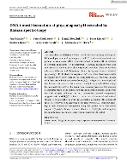DNA i-motif formation at physiological pH revealed by Raman spectroscopy

Autor
Palacký, Jan
Školáková, Petra
Renčiuk, Daniel
Datum vydání
2024Publikováno v
Journal of Raman SpectroscopyRočník / Číslo vydání
55 (1)ISBN / ISSN
ISSN: 0377-0486ISBN / ISSN
eISSN: 1097-4555Metadata
Zobrazit celý záznamKolekce
Tato publikace má vydavatelskou verzi s DOI 10.1002/jrs.6606
Abstrakt
The intercalated motif (iM) is a four-stranded structure consisting of two parallel homoduplexes formed by hemiprotonated C.C+ pairs and intercalated antiparallel to each other. iM is generally formed at acidic pH, as cytosine protonation is required for its formation. However, sequences with long cytosine tracts can form iM at physiological pH conditions. Here, we use both off-resonant Raman and UV-resonant Raman (using synchrotron radiation) spectroscopy (RS) to study the sequence (C9T3)3C9, which has been recently thoroughly analysed by other spectroscopic methods (CD, 1H NMR). In line with these methods, RS has shown that (C9T3)3C9 adopts iM at neutral pH and the iM forms with slow kinetics, melts in multiple steps and exhibits a large thermal hysteresis between the folding and refolding processes. The presence of isosbestic points in the temperature-dependent Raman spectra (in line with the SVD analysis indicating just two independent spectral components) suggests that the (C9T3)3C9 is found as a mixture of disordered and ordered structures, the proportion of which is temperature dependent. The ordered iM species are believed to be composed of the same type of C.C+ pairs but differing in their number and arrangement along the cytosine tracts. The related sequence (C9A3)3C9 shows the same behaviour as (C9T3)3C9, indicating that the substitution of adenine bases for thymine bases has little effect. We apply off-resonant and UV-resonant Raman spectroscopies to study i-motif (iM) formation of the model C rich sequence (C9T3)3C9 at neutral pH. We show that different iM species with different thermal stability and different time kinetics are formed depending on the temperature. SVD analysis demonstrates that the studied sequence adopts (at each time and temperature) a variable proportion of disordered and perfectly ordered iM forms.image
Klíčová slova
cytosine i-motif DNA, pH, Raman spectroscopy, singular value decomposition, UV-resonant Raman
Trvalý odkaz
https://hdl.handle.net/20.500.14178/2919Licence
Licence pro užití plného textu výsledku: Creative Commons Uveďte původ-Neužívejte dílo komerčně-Nezpracovávejte 4.0 International






